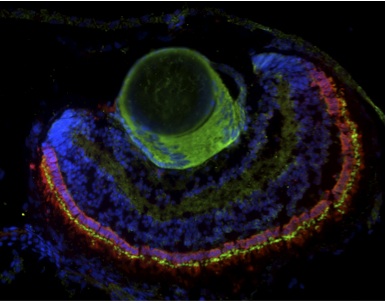Overview
Vision is one of the most crucial senses for humans, and it depends on retinal function. Mutations in retinal genes are non-lethal and can cause specific and disabling forms of retinal degenerations due to photoreceptors deatth, such as Retinitis Pigmentosa. Inherited retinal dystrophies (IRDs) represent the major cause of blindness in the world, for most of which we still have no cure. Even if many of the incvolved genes have been identified, the molecular mechanisms underlying photoreceptors death still need to be fully elucidated. We thus need to develop effective models able to recapitulate molecular mechanisms of disease and that can be used to develop new therapeutic approaches. 
Research directions
Our laboratory studies the factors driving the differentiation and survival of retinal neurons. We aim to identify the mechanisms that maintain retinal function, and how these can be disrupted in pathological conditions. For this, we use a multidisciplinary approach, from three-dimensional cell cultures to genetic models.
Current efforts focus on the characterization of a novel zebrafish model of Retinitis pigmentosa, caused by mutations in IMPG2, a photoreceptor specific proteoglycan. We are also using our model in a medium throughput screen to search for new therapeutic leads.
Group members
- Simona Casarosa, PI
- Maria Elena Castellini, PhD Student
Collaborations
- Emiliano Biasini, CIBIO Dep.t, University of Trento, Italy
- Michela Denti, CIBIO Dep.t, University of Trento, Italy
- Yuri Bozzi, CIMeC, University of Trento, Italy
- Maria Claudia Gargini, University of Pisa, Italy
Funding
Bando: PRIN 2022 (D.D. 104/22)
Investigating the role of IMPG2 in retinal dystrophies by molecular, ultrastructural and behavioral analysis of zebrafish mutants
Simona Casarosa, coordinatrice
Codice Protocollo: 2022JSYEAB CUP: E53D23012160006

Selected publications
Gilmozzi V, Gentile G, Riekschnitz DA, Von Troyer M, Lavdas AA, Kerschbamer E, Weichenberger CX, Rosato-Siri MD, Casarosa S., Conti L, Pramstaller PP, Hicks AA, Pichler I, Zanon A. (2021). Generation of hiPSC-Derived Functional Dopaminergic Neurons in Alginate-Based 3D Culture. Front Cell Dev Biol. 9:708389. doi: 10.3389/fcell.2021.708389. eCollection 2021.
Karali M., Guadagnino I., Marrocco E., De Cegli R., Carissimo A., Pizzo M., Casarosa S., Conte I., Surace E.M., Banfi S. (2019). AAV-miR-204 protects from retinal degeneration by attenuation of microglia activation and photoreceptor cell death. Molecular Therapy 19:144-156. doi: 10.1016/j.omtn.2019.11.005. Epub 2019 Nov 18.
Zhang X, Piano I, Messina A, D'Antongiovanni V, Crò F, Provenzano G, Bozzi Y, Gargini C, Casarosa S. (2019). Retinal Defects in Mice Lacking the Autism-Associated Gene Engrailed-2. Neuroscience. Apr 10. pii: S0306-4522 (19) 30236-2. doi: 10.1016/j.neuroscience.2019.03.061. [Epub ahead of print]
Chelini G, Zerbi V, Cimino L, Grigoli A, Markicevic M, Libera F, Robbiati S, Gadler M, Bronzoni S, Miorelli S, Galbusera A, Gozzi A, Casarosa S., Provenzano G, Bozzi Y. (2019). Aberrant somatosensory processing and connectivity in mice lacking Engrailed-2. J Neurosci. 39:1525-1538. doi: 10.1523/JNEUROSCI.0612-18.2018
Poggi L., Casarosa S., Carl M. (2018). An eye on the Wnt inhibitory factor Wif1. Front. Cell Dev. Biol. doi.org/10.3389/fcell.2018.00167.
Bertacchi M., Lupo G., Pandolfini L., Casarosa S., D’Onofrio M., Pedersen R.A., Harris W.A. and Cremisi F. (2015). Activin/Nodal Signaling Supports Retinal Progenitor Specification in a Narrow Time Window during Pluripotent Stem Cell Neuralization. Stem Cell Reports http://dx.doi.org/10.1016/j.stemcr.2015.08.011
Caputo A., Piano I., Demontis G.C., Bacchi N., Casarosa S., Della Santina L., Gargini C. (2015). TMEM16A is associated with voltage-gated calcium channels in mouse retina and its function is disrupted upon mutation of the auxiliary α2δ4 subunit. Front Cell Neurosci. 9:422. doi: 10.3389/fncel.2015.00422.
Bacchi N, Messina A, Burtscher V, Dassi E, Provenzano G, Bozzi Y, Demontis GC, Koschak A, Denti MA, Casarosa S. (2015). A New Splicing Isoform of Cacna2d4 Mimicking the Effects of c.2451insC Mutation in the Retina: Novel Molecular and Electrophysiological Insights. Invest Ophthalmol Vis Sci. 2015 Jul 1;56(8):4846-56. doi: 10.1167/iovs.15-16410.
Sun W., Incitti T., Migliaresi C., Quattrone A., Casarosa S., Motta A. (2015). Viability and neuronal differentiation of neural stem cells encapsulated in silk fibroin hydrogel functionalized with an IKVAV peptide. J Tissue Eng Regen Med. doi: 10.1002/term.2053.
Messina A., Lan L., Incitti T., Bozza A., Andreazzoli M., Vignali R., Cremisi F., Bozzi Y., Casarosa S. (2015). Noggin-Mediated Retinal Induction Reveals a Novel Interplay Between Bone Morphogenetic Protein Inhibition, Transforming Growth Factor β, and Sonic Hedgehog Signaling. Stem Cells 33(8):2496-508. doi: 10.1002/stem.2043.
